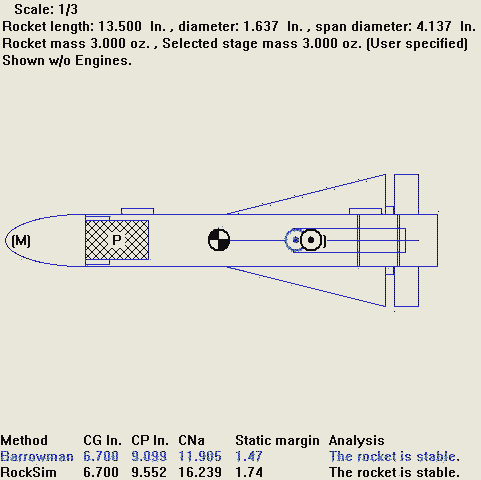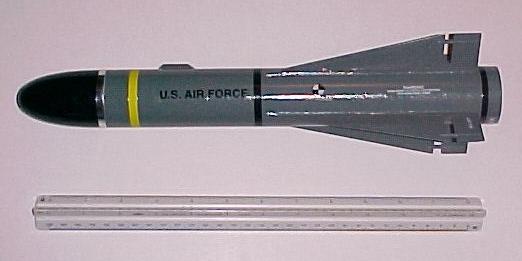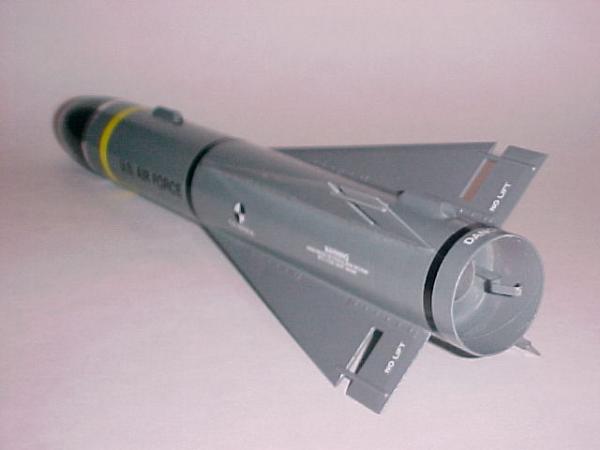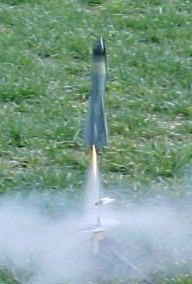| Manufacturer: | Scratch |

This notional missile is the latest in the AGM-65 Maverick air to ground missile systems. Building on the successful AGM-65H with active radar seeker, the "I" model incorporates GPS guidance with active radar terminal guidance.
The idea for this model came when I noticed that the fins on the Estes AGM-57 Heatseeker kit were very similar to those of the Maverick. There are only three fins on the Heatseeker so you'll need two kits. But since the Heatseeker also comes with a set of "excess" Nike-Smoke shaped fins, you still have a pair of complete models. I should point out that I did not set out to build a precise scale model, but only capture the look of a Maverick.
After some quick scaling computations from data obtained from the Missile Index page, I determined that a BT-60 tube was the closest to scale. I used an 11 inch length, a little longer than scale to provide more stability and less nose weight in the finished model. The nosecone is the same as that of the Estes Baby Bertha kit (two of these come in the Estes NC-60A nosecone pack).


The engine mount is 18mm and uses the standard two paper centering ring with engine hook. I took care to align the two centering rings so they were just wide enough for the fin slots to fit between them. The motor is recessed one-half inch into the body tube. A Kevlar® string is tied and epoxied to the MMT for shock cord retention. Shock cord is about two feet of 3/8 inch sewing elastic.
Mounting the fins was the greatest challenge, but was fairly straight forward. First, I printed out a fin alignment wrap in VCP having set the fin width equal to the thickness of the Heatseeker fin tabs. I also made sure the root chord length I entered into VCP was longer than the Heatseeker fin. I taped the fin alignment wrap securely to the body tube, aligning the bottom of the wrap where I needed the base of the fin slot. I carefully measured the positions of the Heatseeker fin slots and colored these locations on the wrap with a Sharpie. Then it was just a matter using a Dremel tool with three cutting wheels to cut out the fin slots using the markings on the fin alignment wrap as a guide. Fins were attached using plastic model cement followed by gap filling CA along the root edges and resulted in sturdy attachment. Fore and aft launch lugs were added to resemble mounting points on the actual missile.
After priming, I used Krylon Smoke Gray gloss for the body and Color Place gloss black (97 cents from WalMart!) for the nose cone. The decals were from the Heatseeker kit and went on very easily for pressure sensitive decals, they are much thinner than those I've used in the past. The stripes were made from self-adhesive Monokote. Finished with two coats of Color Place clear. I like the look of the glossy finish, although the real thing would have a flat finish.

 Modeling clay was
added to the nose to ensure stability - always a necessity in modeling missiles
with a warhead. The model sims to just over 500 feet on a C6-5 and nearly 200
feet on B6-2.
Modeling clay was
added to the nose to ensure stability - always a necessity in modeling missiles
with a warhead. The model sims to just over 500 feet on a C6-5 and nearly 200
feet on B6-2.
First flight was in cold, blustery conditions on an Estes B6-2 with a 9 inch nylon parachute. Boost seemed weak with the rocket arching into the wind to maybe 125 feet. Ejection occurred past apogee with nose down. Nose cone ejected but charge wasn't strong enough to eject the chute. Landed without damage close to the pad. (Did I mention that I soaked both ends of the body tube with thin CA?) Second flight was another B6-2. Perfect - straight boost to roughly 200 feet with ejection nearly at apogee. Nylon chute caught the wind but landed safely within the range. Can't wait to try this rocket in good weather on the C6-5!
 |
 |